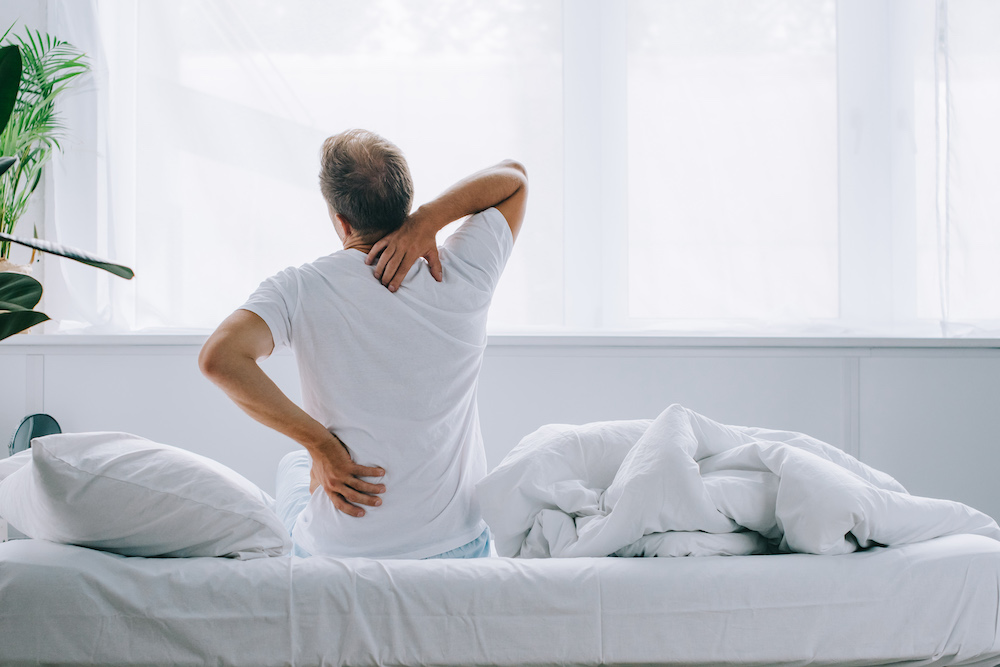How to Sleep with Intercostal Muscle Strain

Do you feel a sharp, throbbing pain accompanying every single breath you take? Most probably, it is either a mild or severe intercostal muscle strain. Such intercostal muscle strains can be difficult to sleep with. If you’re looking for a comfortable sleep with a muscle strain, continue reading to learn more.
Causes of Intercostal Muscle Strain
Intercostal muscle pain is a typical chest pain among people with a sedentary lifestyle and aged people. It simply means that somebody old and skinny is more likely to experience intercostal muscle pain than a person who exercises. Intercostal muscles pains are caused as a result of the muscles between the ribs stretching out. Recurring movement with excessive pressure is the most common natural cause of intercostal muscle strains.
Below is an outline of other common causes of intercostal muscle strain;
- Impact on blow contact sports. The sporting activities can be baseball, tennis, golf, and others
- Experience of chest pain caused by hard falling or hard-hitting. For example, an accidental fall from a ladder
- Engaging in overhead reaching activities such as painting a ceiling
- Activities that involve you in twisting the upper part of your body
- Persistent coughing or sneezing
Signs and Symptoms of Muscle Strain
You should know that pneumonia is a common misdiagnosis associated with intercostal muscle pain. It is advisable to consult a medical specialist because extreme pain might also be emanating from a fractured rib. With that said, it is pretty clear that misdiagnosis of intercostal muscle strain is easy. Be on the lookout for below common symptoms to know when to see a doctor;
- Sensitivity around and between the ribs
- Experiencing shallow breaths or difficulty in breathing as a result of the pain
- Feeling of tightness during coughing, sneezing, stretching, or breathing
- Soreness or muscle swelling around your ribs
Tips on How to Sleep with Intercostal Muscle Strain
You want to sleep better, but the persistent pain won’t let you rest? First things first, sleep is the best remedy for healing intercostal muscles. Below are tips on how to sleep with intercostal muscle strains.
Getting a goodnight’s sleep
Usually, doctors recommend getting a good night’s sleep, whether you’re healthy or not. The recommended sleep time lies between 6 and 8 hours. If your doctor jots down a goodnight’s sleep for you, it shouldn’t be a surprise.
When you’re asleep, the body releases an anti-inflammatory protein called cytokines. This protein helps the body in repairing itself gradually. This is why if you don’t get enough sleep, you’re bound to distort your immune system hence a slow healing process.
Sleep position
Depending on the pain levels, choose a sleeping position that best fits you. Ideally, sleeping on your stomach is not good as it causes more pain. Try to avoid it as much as possible, especially if you've recently undergone a cervical neck surgery. On the other hand, sleeping on your back is the best position.
You can also use a recliner if you’ve chosen this position. If you don’t have a recliner, ensure the chair you’ll be sitting in is comfortable enough for sleep. If you're experiencing throbbing rib pains, you can read the full review on how to sleep with broken ribs.
You can also use a recliner if you’ve chosen this position. If you don’t have a recliner, ensure the chair you’ll be sitting in is comfortable enough for sleep.
Breathing exercises
Mild breathing exercises before bed are essential for a restful sleep. Taking deep breaths might be difficult if you’re already experiencing pain when breathing. If you manage to take these breathing exercises, it will aid significantly in relieving stress by providing oxygen to your body.
Take deep, long inhales slowly for a few minutes and then draw out exhales. As you do this, breathe slowly and steadily. Ensure your breathing exercises aren’t pushing you to the extent of feeling pain in your rib cage. Ultimately, avoid excessive shallow breathing which can cause muscle tension and even turn into panic attacks.
Better mattress choices
As you already know, sleeping is essential in coping with intercostal muscle pains as it is with any other condition, such as an ear infection, or broken ribs. It would be best if you took your time when choosing the best mattress for your condition. Choice of a wrong mattress will equate to difficulty falling or sleeping.
The type of your mattress is always a number one factor. Bear in mind that the price of the mattress does not determine your sleep quality in this situation. Below are some of the factors to consider when choosing the best mattress;
Larger mattress: A larger mattress will go a long way in assuring you of quality sleep. Sleeping with a partner on this mattress is also helpful as you’re less likely to bump on each other.
Spine support: You should also ensure that the mattress you’re purchasing supports your spine’s natural curvature. This means your spine’s curvature should be the same on your natural posture and when lying on the mattress.
Comfort: Many mattress vendors allow their customers to try out different mattresses before buying the one suiting them. You can leverage this opportunity by taking your time to ensure you purchase a comfortable mattress.
Preventing Intercostal Muscle Pain During Sleep
Most of the time that you’ll be feeling the sharp pain on the intercostal muscle is breathing. Breathing in and out will cause your intercostal muscles to stretch and contract, subsequently bringing about the intercostal pain.
As you already know, to stop breathing is not an option. Below are some of the tactics to apply to reduce the chest pains.
Minimize twisting
Keeping your torso neutral and minimizing your twisting can go a very long way in reducing intercostal pain. Shallow breathing to some extent may ease the chest pain significantly, but it may lead to other problems. One such problem is; decreased healing speed.
It is recommended you strictly stick to and follow your doctor’s advice on the breathing exercises you should adopt. Follow your doctor’s prescription accordingly if you want to heal quickly, or else you risk prolonged healing time.
Monitor your inhalation
Depending on the extent of your intercostal muscle strain, your doctor may recommend using a spirometer to monitor your inhalations. It can help you in avoiding excess shallow breaths. Also, you can determine the depth of your inhalation to settle for the level with less discomfort.
Pain relief medication
There are pain relief medications your doctor may prescribe, or you can use over-the-counter meds. If the pain is severe, the doctor might recommend a stronger medication such as corticosteroids or local anesthesia.
Some of these medications can either be applied at the surface of the affected areas or consumed. These meds counteract the pain by reducing swelling and inflammation. That said, if you're experiencing shoulder pain and other pain-related conditions, you can rely on pain relief medication to help you have a restful sleep
Resting upright
It is important to stay upright when resting. The best way this is possible is by using a modified bedframe. You will fall asleep quicker in this position than sleeping horizontally, which might amplify the chest pain to excruciating levels.
Icing the affected area
Icing involves placing a pack of ice over the affected area. This is because ice can Help a lot in reducing inflammation. It would be best if you did the icing for 20 minutes every time you woke up. It is important to note that ice is a natural anti-inflammatory pain reliever.
Massaging the affected area
Massage has been proven to be effective in handling intercostal muscle strains. This practice helps in relaxing tight muscles associated with motion loss and painful breathing. The good thing about this is that you can do it yourself.
When self-massaging, massage the muscle strains using either your thumb or your fingers. You can also opt for pressure motion techniques, ischemic compressions, or precise massage stroke. Below is a step-by-step self-massaging procedure;
- Using either your thumb or fingers, press the strained muscles between your ribs.
- Check for sensitive points within the area starting from the breast bone to the lines of the ribs and then move back to the ribcage side
- Do a general gentle massage on the weak points severally by navigating around the spot using your thumb
- Ensure you don’t slide over the skin when moving over the strained muscles
How long it Takes for Intercostal Muscles to Heal
The healing process and period depends on the intercostal muscle strain severity. The muscle strains with torn muscles take longer time to heal. Mild muscle strains, on the other, take a couple of days to heal, unlike moderate ones that can take up to seven weeks.
It might not be a complete assurance that after a certain period, you shall have completely healed. Other factors include coping techniques. Generally, these techniques involve your sleeping habits, diet routines, physical exercises, and others.
If you’re not doing this right, then you’ll most likely take longer than usual to heal. If you’re looking into assessing the extent of an intercostal muscle strain, check out the methods below;
Grade 1: This is a mild muscle strain with 5% fiber damage. It affects a minimal ratio of the body and takes approximately three weeks to recover fully.
Grade 2: This spans a broader area of fiber muscle damage. However, the severity of the injury is minimal but more than that of grade 1. At this level, you won’t have a complete loss of sense of motion. The recovery period is an average of three months.
Grade 3: At this level, your muscle fibers are considered torn, meaning you have to undergo a surgical procedure to repair the muscles. The recovery period for this grade is longer, though dependent on an individual’s physiology.
Follow Proper Routine
Sleeping difficulty with intercostal muscle strain depends on the severity of the muscle strains. Ensuring you follow proper routines is vital in your healing process. Self-medication is highly discouraged unless recommended by a medical physician. Always know when to see a doctor.
Gabe is the newest member of The Sleep Shop team. If you like the design of The Sleep Shop, give Gabe a thumbs up. He’s a digital marketing and design guru and the brains behind the design and SEO of The Sleep Shop. He also won’t say no to testing a ton of mattresses either, and helps on almost every mattress review.
Learn More About Gabe
